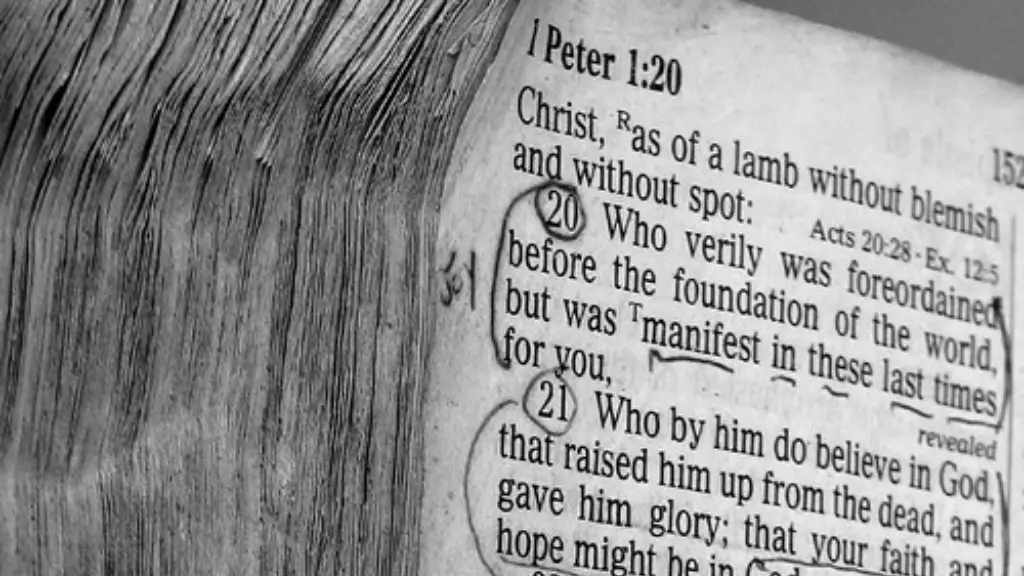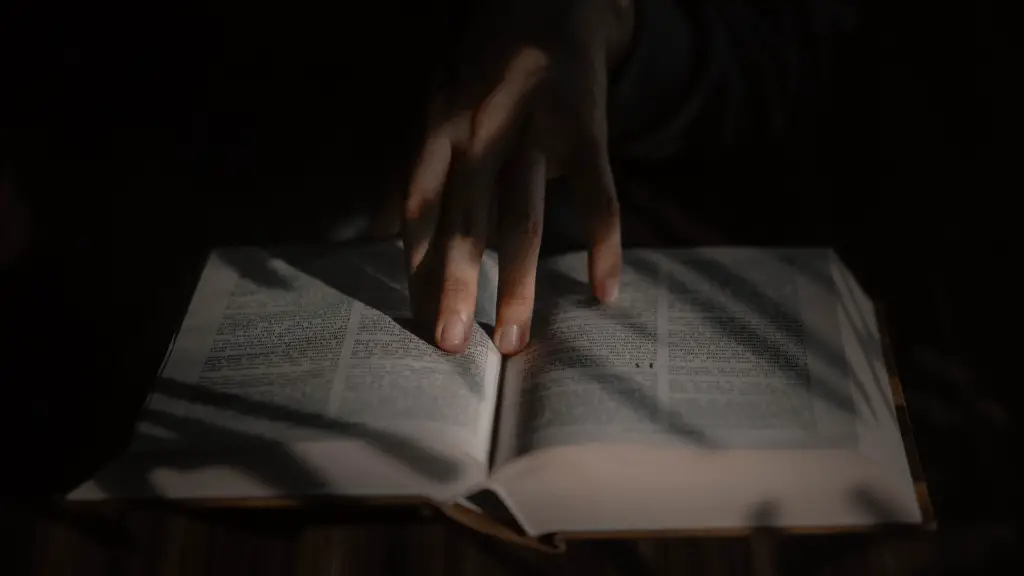What Is The Torah?
The Torah, also known as the Five Books of Moses, is the fundamental, foundational document of Judaism, the oldest monotheistic faith. It consists of the first five books of the Bible (called Pentateuch) and is written in classical Hebrew. Torah is made up of two parts: the Written Torah, meaning the written version of the laws, and the Oral Torah, meaning the spoken and interpreted version that includes traditions and customs. The Written Torah, or the written law, is derived from God’s revelations to Moses on Mount Sinai and the Oral Torah consists of the body of Jewish laws, collectively referred to as Halakhah. Both the Written and Oral Torahs are often called “the Law” and together they comprise the Torah.
Is The Torah In The Bible?
Yes, the entire Torah is preserved in the Old Testament of the Bible. The five books of the Torah– Genesis, Exodus, Leviticus, Numbers and Deuteronomy–are the foundations of the Bible. However, the Torah is not isolated to the Bible, it is an integral part of Jewish life, traditions and religion, and for many Jews, it is the basis of life-long study.
The Bible itself is a collection of ancient Jewish scriptures, called the Tanakh, which is composed of three parts: Torah (Law), Nevi’im (prophets), and Ketuvim (writings). The Tanakh is divided into three distinct parts: the Torah, Nevi’im, and Ketuvim. The five books of the Torah are found, in some form or another, throughout the entire Jewish Bible.
Torah and the Jewish People
The Torah is an integral part of Judaism, the oldest monotheistic faith. The Torah is the foundation of the Jewish faith and its laws are the backbone of Jewish life. Jews see the Torah as a set of instructions given to them by God in order to help them live a right and just life, and to ensure the survival of the Jewish people. Jews also see the Torah as a source of guidance and comfort in times of trouble and strife.
Additionally, Jews view the Torah as a living document, not one frozen in time. Rather, Jews believe that the words of the Torah can be interpreted in different ways according to the time period in which they are read. This principle of interpretation allows Jews to reexamine the fundamental beliefs and teachings of Judaism in order to keep their faith relevant to the modern times.
Authentication of the Torah
In order to authenticate the Torah within the Jewish faith, a system of verification is employed. The Jewish scribes or Sages must make sure that the Torah remains unchanged and unaltered, and is presented in a way that conforms to the laws of the Torah. These Sages are experts in the laws of the Torah and they study the laws as they are initially revealed in the Bible in order to authenticate the Torah and make sure that its laws remain unchanged over time.
The Sages must also make sure that the Torah is preserved for future generations by continuously studying and interpreting the Torah in light of the current generations’ experiences. This ensures that the Jewish people remain connected to the teachings of the Torah and continue to be guided by it in their daily lives. In this way, the Torah remains alive and relevant in the modern world.
Torah and Christianity
While the Torah is an integral part of the Old Testament, it is only a small piece of the Bible as a whole, which consists of the New Testament as well. In fact, the New Testament is seen by many Christians as a new covenant or law known as the New Testament grace or the gospel of Jesus Christ. This new covenant is based on the teachings of Jesus and replaces the laws of the Torah for Christians.
But for many Jews, the covenant of the Torah still stands and its laws still rule their lives. It is up to the individual Jew to choose which path he or she wishes to follow, the path of the Torah or the path of the gospel.
Significance of Torah Today
Today, the Torah remains an important part of Jewish life and has even taken on a larger role in recent years. The growth of the internet has provided a platform for more people to access the Torah and learn more about its teachings and its principles. Additionally, many Jews have begun to take up the cause of social action, using the teachings of the Torah to guide their efforts in fighting for a more just and equitable society.
Throughout the years, the Torah has been able to remain relevant and serve as a source of guidance and inspiration, even in times of turmoil and change. It is through the Torah that Jews remain connected to their past and grounded in the present, and it provides them with a roadmap to a better future.
Interpretation of the Torah
The Written and Oral Torahs are often called “the Law” and together they comprise the Torah. Over time, the Torah’s laws and teachings have been reinterpreted and given new meaning based on the changing world in which Jews live. This reinterpretation gives Jews the opportunity to apply their understanding of the world to the teachings of the Torah, allowing them to create a fresh perspective and add new layers to the text.
Additionally, this reinterpretation also serves the purpose of helping Jews connect to the text on a personal level. Jews can read the words of the Torah and relate to different parts of it, giving them a greater understanding of the text and a more meaningful relationship with it.
Contemporary Analysis of the Torah
In today’s world, the Torah is being analyzed through more contemporary lenses. Scholars use insights from art, political theory and other disciplines to unpack the meaning in the text. This allows for more diverse interpretations and more meaningful conversations around the Torah and its teachings.
Additionally, the interpretation of the Torah can be seen in different forms of art, such as literature, music, movies and television shows. Though these art forms may not directly reflect the teachings of the Torah, they offer their own interpretations and insights into the text, which can help Jews to find new ways to connect with it.
Interfaith Dialogue and the Torah
In recent years, interfaith dialogue has become an important part of understanding and appreciating the beliefs and traditions of different faiths. As part of this dialogue, Jews and Christians have come together to discuss the meaning and relevance of the Torah in their respective faiths. Through this dialogue, Jews and Christians are able to gain new perspectives and insights into the Torah and its teachings.
More broadly, this dialogue promotes understanding and respect between the two faiths and fosters a more peaceful coexistence. It is through dialogue and understanding that Jews and Christians are able to recognize and appreciate the commonalities between their two faiths, further strengthening the connection between them.
Adaptation of the Torah into Creative Art
The Torah’s teachings have been adapted into many forms of creative art, such as literature, music, film and television. These works offer insights into the meaning of the Torah and its relevance in the modern world. By exploring the Torah through creative art, Jews are able to gain new perspectives on the text and form more meaningful connections with the laws of the Torah.
Additionally, these works of art can also help to promote understanding between Jews and other faiths. Through these art forms, Jews are able to share their faith with others and foster dialogue and understanding between different beliefs and cultures.
Interweaving of Historical and Contemporary Religious Practices
In recent years, there has been an increased focus on weaving together historical and contemporary religious practices. Modern Jews are exploring ways to seamlessly integrate the traditional teachings of the Torah with more recent insights. This process allows Jews to gain a greater understanding of the Torah, while also exploring more liberal interpretations of their faith.
These efforts have helped Jews to create a more meaningful and enjoyable experience of studying and living the Torah’s teachings. By incorporating contemporary interpretations of the Torah into their practice, Jews are able to create a more dynamic and vibrant relationship with the text.
Inclusion of Technology Into Torah Study
In recent years, technology has begun to play a larger role in Torah study. Through the use of technology, such as online resources and mobile apps, Jews are able to access the Torah and its teachings in new and exciting ways.
Through these resources, Jews are able to gain a more comprehensive and real-time understanding of the Torah. Additionally, technology is also allowing Jews to explore the text in different ways and to share the text with a larger audience.
Expansion of Torh Learning Beyond the Written Word
In recent years, more Jews have begun to explore the teachings of the Torah beyond the written words. Through experiential learning and immersive simulations, Jews are able to gain a deeper understanding of the Torah and form a more meaningful relationship with its teachings.
This experiential learning also allows Jews to gain a more personal understanding of the Torah and its teachings. By engaging with the text in meaningful ways, Jews are able to create an experience of learning that is both enlightening and enjoyable.



